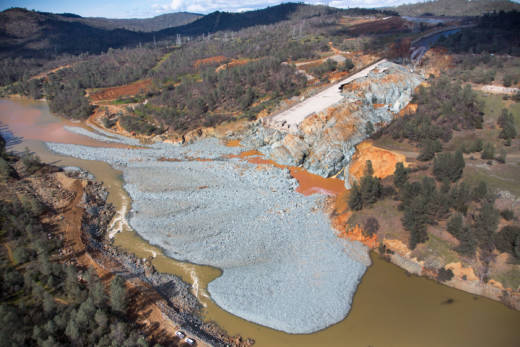The discharge transformed the river into a turbid, mud-filled stream and forced the state Department of Fish and Wildlife to rescue millions of juvenile salmon from its Oroville hatchery and transfer them to another facility nearby.
"The deleterious nature of the material was spotlighted and proved by the evacuation of the Feather River Fish Hatchery," Ramsey said. "It was too dangerous for the salmon and steelhead there."
Ramsey said the Fish and Game Code does not require the county to show anything beyond the fact the Oroville spillway debris was harmful to wildlife.
"There's no need to prove that they willfully or negligently intended to pass through deleterious material. Basically, you dump, you're liable," he said.
Butte County officials, state legislators and local residents have complained for months that DWR has failed to address the issue of sediment that remains in the river and other impacts from the debris. Agency Deputy Director Cindy Messer told an Assembly committee hearing last month that DWR was "currently having dialogue with the members of the various communities to talk about that particular item."
The Butte County lawsuit estimates the weight of the Oroville spillway sludge at between 2,000 pounds and 3,000 pounds per cubic yard. Multiplying that number by 1.7 million -- the number of cubic yards -- yields an overall weight estimate of 3.4 billion to 5.1 billion pounds. The state law's maximum penalty of $10 per pound would bring the DWR's total fine to between $34 billion and $51 billion.
If the suit seeks to base the penalty on the larger 2.2 million cubic yard figure DWR currently cites, the maximum penalty could reach $66 billion.
The suit also asks for a $25,000 per day penalty to be levied for the period between Feb. 7 and Feb. 27, 2017, when most of the debris was washed into the river.
To put $51 billion (or $66 billion) into perspective: Gov. Jerry Brown's proposed 2018-19 budget, which covers everything California state government does, is $190 billion. The state's bullet-train project carries a projected price tag of $67 billion. The estimated cost of the proposed Delta tunnel project has been put at $10 billion for a newly scaled-down version. The entire Department of Water Resources 2017-18 budget, including funding for operating the State Water Project, is about $2.4 billion.
But those outlandish-sounding penalties may never come to pass.
The law specifies $10 per pound as the maximum penalty, and a court could set a lesser amount if it finds DWR liable for the alleged dumping. The law also calls for penalties to be reduced "for every ... pound of the ilegally discharged material that is recovered and properly disposed of by the responsible party."
The Department of Water Resources reported last May it had removed virtually all of the 1.7 million cubic yards of debris that it said wound up at near the foot of the shattered concrete spillway.
DWR now says that it has recovered 1.4 million cubic yards of the 2.2 million it now estimates washed into the river.
